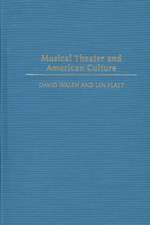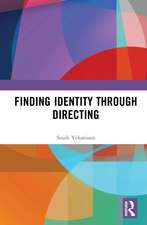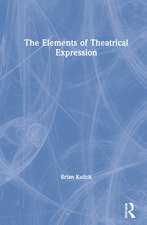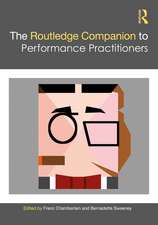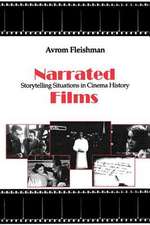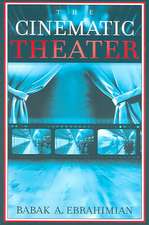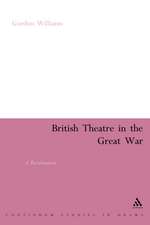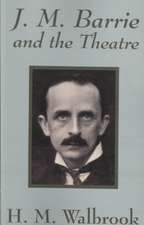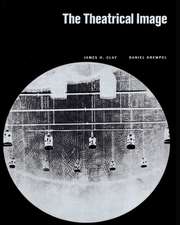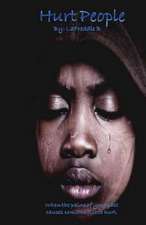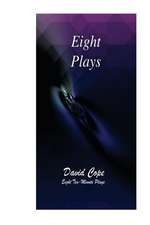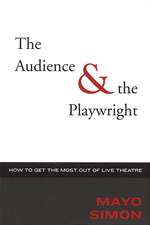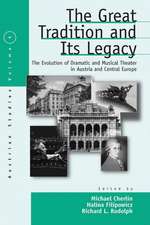What Would Garrick Do? Or, Acting Lessons from the Eighteenth Century
Autor James Harriman-Smithen Limba Engleză Paperback – 24 ian 2024
| Toate formatele și edițiile | Preț | Express |
|---|---|---|
| Paperback (1) | 165.48 lei 22-36 zile | +27.23 lei 5-11 zile |
| Bloomsbury Publishing – 24 ian 2024 | 165.48 lei 22-36 zile | +27.23 lei 5-11 zile |
| Hardback (1) | 466.65 lei 43-57 zile | |
| Bloomsbury Publishing – 24 ian 2024 | 466.65 lei 43-57 zile |
Preț: 165.48 lei
Preț vechi: 178.72 lei
-7% Nou
Puncte Express: 248
Preț estimativ în valută:
31.67€ • 34.42$ • 26.62£
31.67€ • 34.42$ • 26.62£
Carte disponibilă
Livrare economică 31 martie-14 aprilie
Livrare express 14-20 martie pentru 37.22 lei
Preluare comenzi: 021 569.72.76
Specificații
ISBN-13: 9781350171961
ISBN-10: 1350171964
Pagini: 256
Ilustrații: 15 bw illus
Dimensiuni: 138 x 216 x 25 mm
Greutate: 0.32 kg
Editura: Bloomsbury Publishing
Colecția Methuen Drama
Locul publicării:London, United Kingdom
ISBN-10: 1350171964
Pagini: 256
Ilustrații: 15 bw illus
Dimensiuni: 138 x 216 x 25 mm
Greutate: 0.32 kg
Editura: Bloomsbury Publishing
Colecția Methuen Drama
Locul publicării:London, United Kingdom
Caracteristici
Offers a provocative challenge to contemporary theatrical norms, encouraging independence of actors in rehearsal and performance, while providing directors with a new vocabulary for framing their vision of a play
Notă biografică
James Harriman-Smith is a lecturer and public orator at Newcastle University, UK. His research focusses on writing about acting in the 18th century and he has published widely on aesthetics, editorial and performance theory.
Cuprins
IntroductionThe Essays:EmotionCultivationCharacterVoiceActionCompanyAudienceReflectionThe Exercises:Garrick's ScaleDramatic GestureAttitudesType and ScenarioProteusFalse ToneCue-ScriptMacklin's GardenEmphasisUniversal ExpressionFive RoomsThe HissGreat SensibilityClairon's ModelAppendixWorks CitedIndex
Recenzii
An original, learned, and practical book, which not only brings the theatre of the eighteenth century to vibrant and immediate life, but also makes Garrick's theatre useful to the theatre of today. A hugely enjoyable and absorbing study of a long-neglected and underrated era of theatre history.
The strength of this book is that it covers in an innovative and creative way a still-neglected and under-researched area of theatre history: the art and training of the actor in the 18th century. It collates, and comments upon, a range of varied texts on how the actor trained, and the theory of acting, from the 18th century in such a way as to interest a number of audiences: the theatre historian, the 18th century literary critic, the drama student at university, the professional actor-in-training and the actor trainer. It suggests an innovative practical method of researching through practice with theatre practitioners, which brings to life and implicitly argues for the on-going usefulness and interest of the material ... This book brings 18th century theatre theory into the rehearsal room and shows contemporary actors both how actors thought about their craft in the past, but also shows how their exercises and thinking can be used today by directors and actors. The idea is that 18th century ideas about acting can still be relevant and useful to actors today - or can be a starting point for exploring both 18th century plays and plays of today ... It is a refreshing and innovative approach to being open-minded about acting practices of the past, trying them out 'on the floor' and discovering more about how actor moved, spoke and imagined themselves into plays in the past, making these approached available to us today for experimentation and illumination.
Effectively the first in-depth examination of the theory and practice of acting /directing in the long eighteenth century. Given that post-1660 women were for the first time permitted to act on stage in England, the author's strong interest in examining both the significance of the change and its analysis by female actors - as well their male counterparts - is of great importance: for this change alone would slowly alter the way in which gender representation was enacted and the way in which questions of responsibility/status began to shift. This latter point is particularly significant in what the author has to say about the emergence of a star system. It is offering a combination of the historical and the contemporary in a way that is unprecedented, and is very different from the approach taken by excellent theatrical historiographers such as Thomas Postlewait, whose efforts are concerned with attempts to recover the past, rather than connecting that past with the present.
Peeling back the celebrity gloss, this book delves into the performance practice that thrilled 18thc theatre audiences, offering a range of exercises for the modern performer seeking to bring all kinds of plays to life today.
The focus on collaboration between academic research/theory and practical application is the best part of the proposed work. The note that these methods can be then customized and further developed to suit someone's needs, even outside the specialization of 18th century theatre, promises to be a useful tool in teaching acting ... The publication of this book would provide a new way of examining and embodying a specific historical period and its theatrical style.
The volume would be a welcome and significant enhancement of this area, building on and alongside projects such as Richard Schoch and Amanda Winkler's Performing Restoration Shakespeare ... [This book] has the potential to be an invaluable teaching and research resource ... Both the subject matter and the methodological approach are sound and deserve wider dissemination. More publications which truly blend theatre history and practice are sorely needed.
The strength of this book is that it covers in an innovative and creative way a still-neglected and under-researched area of theatre history: the art and training of the actor in the 18th century. It collates, and comments upon, a range of varied texts on how the actor trained, and the theory of acting, from the 18th century in such a way as to interest a number of audiences: the theatre historian, the 18th century literary critic, the drama student at university, the professional actor-in-training and the actor trainer. It suggests an innovative practical method of researching through practice with theatre practitioners, which brings to life and implicitly argues for the on-going usefulness and interest of the material ... This book brings 18th century theatre theory into the rehearsal room and shows contemporary actors both how actors thought about their craft in the past, but also shows how their exercises and thinking can be used today by directors and actors. The idea is that 18th century ideas about acting can still be relevant and useful to actors today - or can be a starting point for exploring both 18th century plays and plays of today ... It is a refreshing and innovative approach to being open-minded about acting practices of the past, trying them out 'on the floor' and discovering more about how actor moved, spoke and imagined themselves into plays in the past, making these approached available to us today for experimentation and illumination.
Effectively the first in-depth examination of the theory and practice of acting /directing in the long eighteenth century. Given that post-1660 women were for the first time permitted to act on stage in England, the author's strong interest in examining both the significance of the change and its analysis by female actors - as well their male counterparts - is of great importance: for this change alone would slowly alter the way in which gender representation was enacted and the way in which questions of responsibility/status began to shift. This latter point is particularly significant in what the author has to say about the emergence of a star system. It is offering a combination of the historical and the contemporary in a way that is unprecedented, and is very different from the approach taken by excellent theatrical historiographers such as Thomas Postlewait, whose efforts are concerned with attempts to recover the past, rather than connecting that past with the present.
Peeling back the celebrity gloss, this book delves into the performance practice that thrilled 18thc theatre audiences, offering a range of exercises for the modern performer seeking to bring all kinds of plays to life today.
The focus on collaboration between academic research/theory and practical application is the best part of the proposed work. The note that these methods can be then customized and further developed to suit someone's needs, even outside the specialization of 18th century theatre, promises to be a useful tool in teaching acting ... The publication of this book would provide a new way of examining and embodying a specific historical period and its theatrical style.
The volume would be a welcome and significant enhancement of this area, building on and alongside projects such as Richard Schoch and Amanda Winkler's Performing Restoration Shakespeare ... [This book] has the potential to be an invaluable teaching and research resource ... Both the subject matter and the methodological approach are sound and deserve wider dissemination. More publications which truly blend theatre history and practice are sorely needed.

